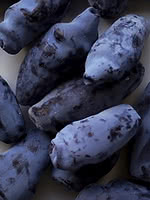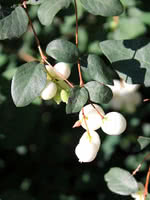Mon-Fri 9am - 5pm Mountain time
Aurora Haskap (Honeyberry) vs Western Snowberry
Lonicera caerulea Aurora
Symphoricarpos occidentalis
NOT AVAILABLE THIS SEASON - MIGHT RETURN
Aurora Haskap is considered one of the top Haskap varieties, known for its excellent flavour and lower acidity, resulting in a sweeter taste. The flavour of Haskaps is generally described as a cross between a blueberry and a raspberry. Aurora Haskaps are well suited to fresh eating, freezing, baking, and preserves.
It produces high yields of large berries and the upright growth habit makes it suitable for mechanical harvesting. The berries are easily seen on the bush, making them easy to pick.
For optimal fruit production, cross-pollination is required. Haskaps need to be planted with a compatible variety. Compatibility is influenced by both bloom time and genetics.
Aurora Haskap is an early-pollinating variety and pairs well with Borealis, Tundra, Honey Bee, and Indigo Gem.
Like the Common Snowberry, the Western Snowberry is a small shrub with pink flowers useful for feeding livestock and preventing erosion. Unlike the common species, however, the Western Snowberry is much more suited to wet conditions, capable of persevering through poor soil drainage and occasional flooding.
After the Snowberry's flowers have bloomed, it produces berries which often last on the plant through winter. These berries are toxic to humans, but livestock and local wildlife love them! Those hoping to attract wildlife to their property can plant Snowberry and expect to see animals foraging on it much later in the year than other plants.
Aurora Haskap (Honeyberry) Quick Facts
Western Snowberry Quick Facts
Toxicity: berries are toxic to humans

